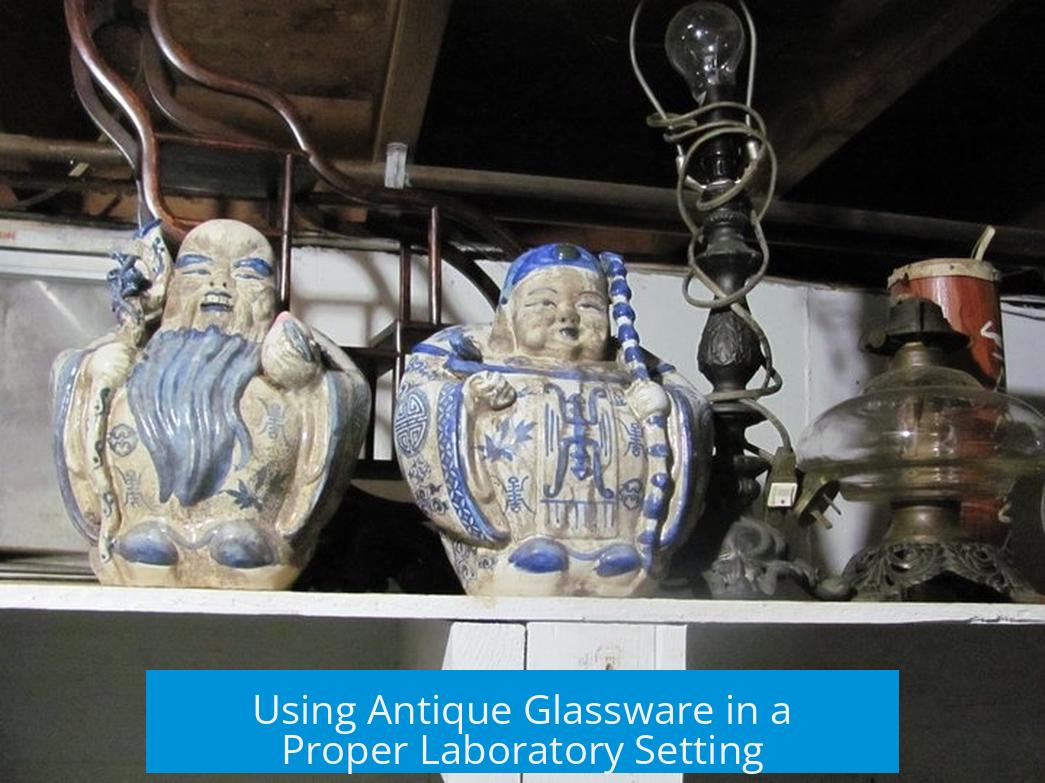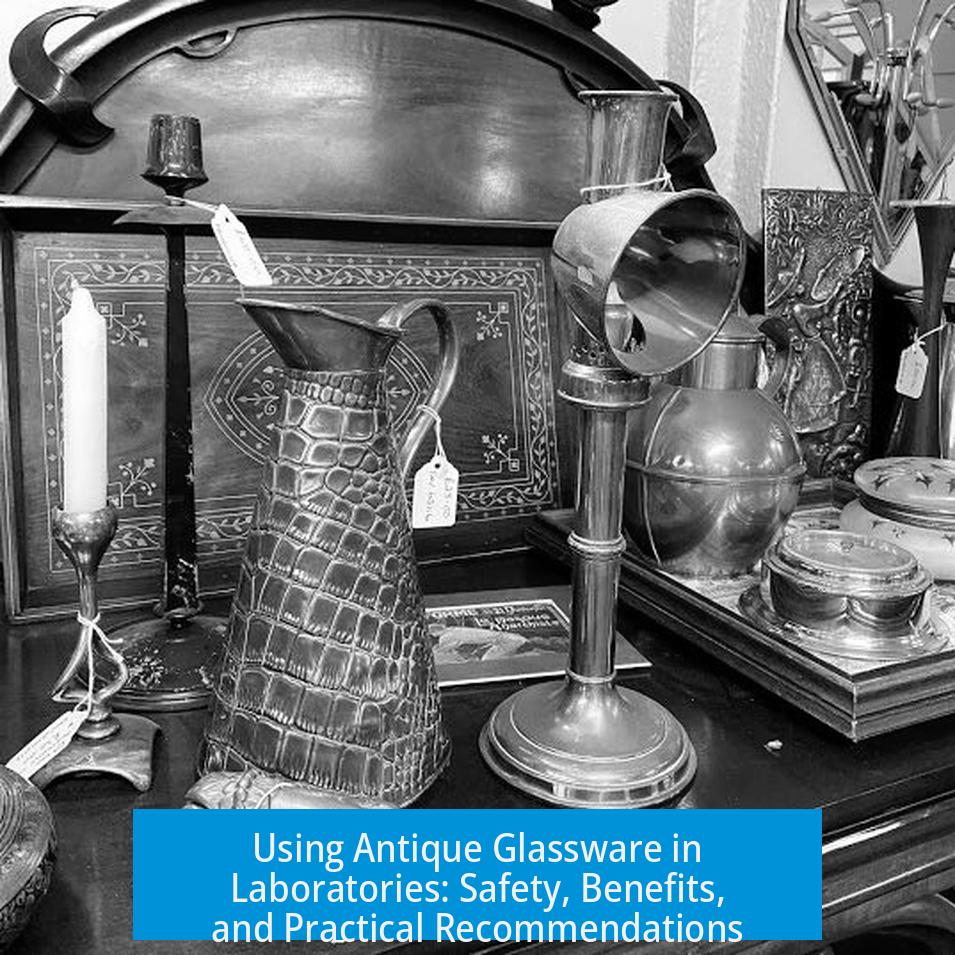Using Antique Glassware in a Proper Laboratory Setting

Using antique glassware in a proper lab is generally acceptable, provided the glassware is of suitable material such as borosilicate, free of cracks, and shows no signs of chemical etching or damage. Many labs routinely use glassware that is decades old, and as long as it passes visual and safety inspections, it can function effectively in standard lab procedures without compromising safety or accuracy.
Understanding Antique Glassware and Its Age
Antique glassware typically refers to collectible items over 100 years old. However, much of the “old” glassware encountered in laboratories is not antique by this strict definition. For example, ground glass joints, which are standard in modern lab glassware, were first invented in 1915. Glassware with a ground joint would be at most around 108 years old. Yet, most lab glassware marked as “made in West Germany” dates from the mid to late 20th century, often more than 30 or 40 years old but less than a century.
Borosilicate glass, favored in laboratories for its chemical and thermal resistance, does not degrade significantly over decades. Thus, glassware even 35 to 50 years old remains viable for use except when damaged. Some instruments, like thermometers from the 1950s or older, are still in use where precision and durability remain uncompromised.
Material and Physical Condition: Key Factors
The primary concern for using older glassware in labs is the type of glass and its condition. Borosilicate glass is preferred due to its stability. Many older glass pieces are made from borosilicate and are often thicker than modern equivalents. This thickness provides added durability, which can be advantageous.
- Check for cracks or star-cracks, which could compromise structural integrity.
- Minor chips, especially on the lip of flasks or beakers, usually do not impair function.
- Visible imperfections, stress points, or etching caused by chemicals like hydrofluoric acid or strong alkalis should be avoided.
- Visual inspection under polarized light aids in detecting internal stresses and flaws not seen by the naked eye.
When these quality checks pass, antique or old glassware can be as safe and effective as new glassware.
Ground Glass Joints and “Antique” Classification
Glassware incorporating ground glass joints is generally not considered antique since these joints were introduced in the early 20th century. Despite this, such glassware is often older, yet perfectly suitable for laboratory use if undamaged.
Standard taper joints enable easy assembly of complex apparatus like distillation setups or reflux condensers. Provided the joints are intact and joint surfaces clean, these pieces remain functional regardless of age.
Practical Uses of Antique Glassware in Laboratories
Many labs rely on older glassware for typical procedures, including acid leaching, aqua regia digestion, titration, and distillation. Some labs operate primarily with decades-old equipment and only replace frequently broken items, such as small beakers or flasks.
Examples of common vintage glassware usage include:
- Acid tanks and chemical digestion vessels made from thick, older borosilicate glass.
- Soxhlet extractors over 35 years old still functioning reliably.
- Thermometers from the mid-20th century for routine temperature monitoring.
The reasoning is simple: glassware does not “expire” like consumables. If properly maintained and inspected, it remains functional and safe.
Laboratory Culture and Attitudes Toward Glassware Age
Some labs embrace the tradition of using older glassware, viewing new purchases as unnecessary or a luxury reserved for well-funded groups. The common sentiment is that demonstrated functional reliability matters more than the age or modernity of the equipment.
“Most of our flasks and beakers are antiques!”
“New glassware is for (grant) winners.”
Even safety officers who have inspected multiple labs report seeing a wide variety of glassware in use, from antique flasks to repurposed containers like jam jars or sample tubes. With the exception of materials like mugs—which pose safety and contamination risks—older glassware is accepted if it fits the usage conditions and labs maintain vigilance about safety.
Safety Considerations and Usage Restrictions
While antique or old glassware can be used safely, certain conditions limit their use to reduce risk:
- Avoid use in operations involving extreme heating, cooling, or applied pressure, unless the glassware was expressly designed for such conditions.
- Never use chipped or cracked glassware under vacuum or high-pressure reactions.
- Inspect thoroughly for stress, chemical damage, or defects before use.
- If unsure, consult your laboratory supervisor, lead technician, or chemical safety officer.
- Replace frequently broken or heavily handled glassware regularly to maintain safety and reliability.
Adhering to these precautions minimizes danger and maintains lab integrity.
Summary Table: Pros and Cons of Using Antique Glassware in Labs
| Aspect | Pros | Cons |
|---|---|---|
| Material Stability | Borosilicate glass lasts decades without degradation. | Damage or chemical etching weakens glass. |
| Cost | Using existing old glassware saves purchasing costs. | Potential hidden damage can lead to breakage. |
| Safety | Passed inspections allow safe usage. | Cracks or chips cause hazards if pressurized or heated. |
| Performance | Older, thicker glass may offer increased durability. | May lack modern precision or standardization. |
| Lab Culture | Traditional labs embrace old glassware. | New labs or compliance settings may prefer certified modern glassware. |
Concluding Key Takeaways
- Antique glassware over 100 years old is rare in labs; most “old” glassware is decades old but still effective.
- Borosilicate glass is stable and durable; age alone does not impair function.
- Inspect glassware carefully for cracks, chips, or chemical damage before use.
- Ground glass joint pieces are usually not antique but remain safe if intact.
- Avoid antique glassware in processes involving heating, cooling, or pressure unless the piece is designed for such.
- Many labs successfully use glassware decades old and replace only frequently broken items.
- Consult supervisors or safety officers when in doubt.
- Exclude inappropriate items like mugs due to contamination and safety risks.
Can antique glassware be safely used in modern laboratories?
Yes, antique glassware can be used if it is borosilicate and free from cracks or star-cracks. Visual inspection and polarized light checks help confirm safety.
Are ground glass joints considered antique glassware suitable for lab use?
Glassware with ground glass joints is generally not considered antique but is acceptable if undamaged. These joints are designed for chemistry and lab use.
What limitations apply when using antique glassware in experiments?
Antique glassware should not be used for heating, cooling, or experiments involving pressure or vacuum unless specifically designed for these conditions.
How do labs generally view the use of old or antique glassware?
Many labs prefer or accept old glassware. It is often thicker than new glass and considered reliable. Some labs consider new glassware a luxury.
Is any antique glassware completely off-limits in labs?
Mugs and similar containers are discouraged due to contamination and safety risks. Other antique glassware, if in good condition, is widely used.
Who should be consulted if unsure about using antique glassware?
If questions arise, always ask a supervisor, lead technician, or chemical safety officer before using antique glassware in a lab.




Leave a Comment